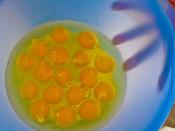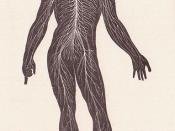The sperm fertilizes the egg and forms a 2N zygote. Once fertilization is completed, a succession of rapid cell divisions ensues. During cleavage, the cells undergo the S (DNA synthesis) and M (mitosis) phases of the cell cycle but virtually skip the G1 and G2 phases, so little or no protein synthesis occurs. The embryo does not enlarge during this period of development. Cleavage parts the cytoplasm into many smaller cells called blastomeres, each with its own nucleus. The first five to seven divisions form the morula. A fluid-filled cavity called the blastocoel begins to form within the morula and is fully formed in the blastula. Yolk is most concentrated toward one pole of the egg, called the vegetal pole; the yolk concentration decreases significantly toward the opposite pole, the animal pole. The animal pole cortex moves toward the point of sperm entry, and the vegetal hemisphere cortex across from the point of sperm entry moves toward the animal hemisphere.
Thus, cortical rotation establishes the dorsal-ventral axis of the zygote. In some species, the gray crescent is formed. Gastrulation rearranges the cells of the blastula to form a three-layered embryo with a primitive gut. The result of gastrulation is that some of the cells at or near the surface of the blastula move to an interior location, and three cell layers are established. The three-layered embryo is called the gastrula. The ectoderm forms the outer layer of the gastrula; the endoderm lines the embryonic digestive tract; and the mesoderm partly fills the space between the ectoderm and the endoderm. Eventually, these three cell layers develop into all the tissues and organs of the adult animal. Various regions of the three embryonic germ layers develop into the rudiments of organs during the process of organogenesis. The first evidence...


